| toledo | popcorn
call / pit-pit-pit |
owng | ||
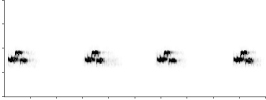 |
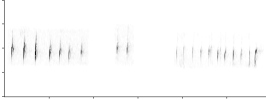 |
 |
||
| The male-male toledo duet is the Long-tailed Manakin's most prominent call. In fact, the Spanish common name for Long-tailed Manakins is "Toledo"! The toledo duet is a long-range signal given by pairs of males to attract females. | The popcorn call is a quiet vocalization given by pairs of
males before they sing a bout of toledo
duets. It appears to function in coordinating the two males' songs. The
pit-pit-pit sound is
sung by both males and may be thought of as a duet. |
The owng call is a
quiet vocalization given by males while they are singing in the canopy.
It may stimulate a newly-arrived female to descend to the dance perch
so the males can begin their display. It usually sounds like a
question: owng? |
||
|
|
||||
| dance song | buzz-kweet | waanh | ||
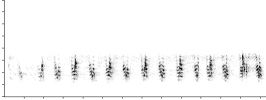 |
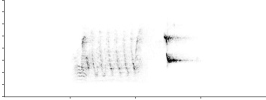 |
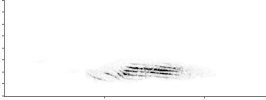 |
||
| The dance song is a loud call given by pairs of males as
they perform their acrobatic display. Each time a male leap-frogs over
the other male, he sings one syllable of this song. Therefore, the
dance song may be thought of as a form of duet. |
After a period of leap-frog dancing, the loud buzz-kweet
call is given by the dominant male. The subordinate male
usually leaves the area after this call, at which point the dominant
male may perform a solo display. |
The waanh call is
a relatively quiet whine given by males from the subcanopy. It is sung
by both young and old males in a variety of contexts, usually away from
their dance perch. |
||
|
|
||||
| teeamoo | pee-wit / pee-wit-oh | weet | ||
 |
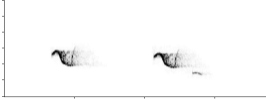 |
 |
||
| The teeamoo call
is a long-range signal given by the dominant male to attract his
subordinate male partner. The teeamoo
call can be thought of as the call an alpha male gives to tell his beta
male to "get to work!" |
The pee-wit-oh
call is similar to the teeamoo,
but it is quieter and the first syllable rises at the end. The function
of the pee-wit and the pee-wit-oh calls are unclear. |
This weet call is
a loud sound given from the subcanopy. It is an alarm call. |
||
|
|
||||
| wheeoo | doo-doo-doo | toodleloo | ||
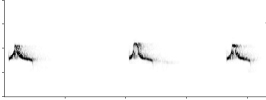 |
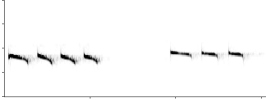 |
 |
||
| The wheeoo call is
also an alarm call. Many Long-tailed Manakins will gather together and
sing wheeo choruses in the
presence of a predator or a rival Long-tailed Manakin. |
The doo-doo-doo
call is a series of three or four repeated notes that subtly fall in
pitch. It is a somewhat quiet vocalization given from the subcanopy and
its function is unclear. |
This is a very quiet vocalization which is similar to the doo-doo-doo call, except that the
notes alternately rise and fall in pitch. Like the pee-wit / pee-wit-oh and doo-doo-doo calls, the function of
the toodleloo call is
unclear. |
||
|
|
||||
| male chitter | female chitter | squawk | ||
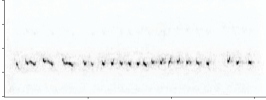 |
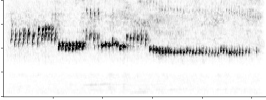 |
NA |
||
| Male chitter is a very quiet vocalization. It appears to be
given primarily by subordinate males. |
Female chitter is a very quiet and rarely-heard
vocalization. It is more variable than male chitter and its function is
unknown. |
The squawk sound
is a distress call given by Long-tailed Manakins when they are caught
in mist-nets. We have not heard it in any other context. |
||
| The following
paper is recommended reading for anyone interested in the
details of the Long-tailed Manakin's vocal repertoire: Trainer JM & McDonald DB. 1993. Vocal repertoire of the long-tailed manakin and its relation to male-male cooperation. Condor 95:769-781. (Download free from http://elibrary.unm.edu/sora/) Note that Jill Trainer and Dave McDonald use slightly different terminology in their article than we do on this webpage. What we call the "popcorn call / pit-pit-pit" they call "wit". What we call the "buzz-kweet" they call the "buzz-weent". What we call the "dance song" they call "nyanyownh". They use the term "toodleloo" to describe a number of variable vocalizations; we subdivide this category into the "toodleloo" vocalization and the "pee-wit / pee-wit-oh" sounds. This page was coauthored by Dan Mennill and Stephanie Doucet. Return to... The Bird Songs of Santa Rosa "Bird Songs" Page Dan Mennill's Homepage Stephanie Doucet's Homepage |
All
information on this website is copyright Daniel Mennill 2005 unless
otherwise indicated. No
recordings, photographs, or other information may be used without
written permission from me. Please email me at dmennill AT uwindsor DOT ca
and I will happily grant permission for most non-commercial or
educational
purposes.

|






 The
Long-tailed Manakin has a fantastic vocal repertoire
to accompany a fantastic mating system. Male Long-tailed Manakins form
alliances and gather at mating arenas called "leks". Pairs of males try
to attract females to these leks by singing loud
The
Long-tailed Manakin has a fantastic vocal repertoire
to accompany a fantastic mating system. Male Long-tailed Manakins form
alliances and gather at mating arenas called "leks". Pairs of males try
to attract females to these leks by singing loud 


